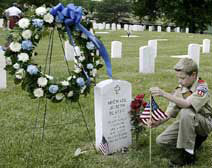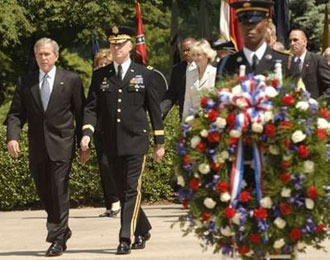Human Flower Project
Monday, May 30, 2005
With Wreaths
Why do circular flower arrangements mean “in memoriam”?
Memorial Day and Halloween are the only two dates on the calendar when U.S. citizens admit to death. The other 363 days a year, we’re getting ahead, we’re working out with weights. We’re just fine!
 Keven Outman
Keven Outman
at the grave of
Lt. Michael Joseph Blassie
St. Louis, MO
Photo: Associated Press
Today’s solemn occasion was first observed 137 years ago, when an Illinois Union general sent an order to Civil War veterans. John A. Logan wrote:
“The 30th day of May, 1868, is designated for the purpose of strewing with flowers or otherwise decorating the graves of comrades who died in defense of their country during the late rebellion, and whose bodies now lie in almost every city, village and hamlet churchyard in the land. In this observance no form of ceremony is prescribed, but posts and comrades will in their own way arrange such fitting services and testimonials of respect as circumstances may permit.”
In many places throughout the U.S., Memorial Day will be publicly observed with the laying of wreaths; aboard the U.S.S. San Diego; at Hollywood Cemetery, near Richmond, Virginia, “honoring 76 former John Marshall High School cadets killed in the service of their country”; at the Intrepid Museum in New York. In Newport, Oregon, a fleet of boats will take memorial wreaths out into Depoe Bay, a custom six decades old.
And of course at Arlington National Cemetery, President George Bush laid a wreath this morning at the Tomb of the Unknowns.
Why all the circular arrangements? This story about the history of Memorial Day notes: “The fact that the (Civil) war ended during the flowering of springtime had much to do with the form the holiday eventually took. Some historians, including the one-time Chicago newspaper editor Lloyd Lewis, have also seen the day’s roots in the North’s elaborate grieving after the April 14, 1865, assassination of President Abraham Lincoln.”
In other words, this holiday for remembrance of the war dead was born in a flowering season, and in a floral era, when public expression took form in roses and sweet peas rather than opinion polls and souvenir t-shirts. That explains how flowers became part of Memorial Day, but why have they—floral wreaths in particular—endured, an observance even in our decidedly non-floral times?
 Pres. George Bush
Pres. George Bush
Arlington National Cemetery
May 30, 2005
Photo: Mannie Garcia, for Reuters
According to Nora T. Hunter’s essay in The Centennial History of the American Florist, the wreath symbolized eternal life, eternal love, and “victory over death.” Before flat sprays came into fashion, in the latter part of the 19th century, “the wreath was the most requested sympathy design.”
I see wreaths used today, in the U.S. anyway, as emblems of collective sentiment, something different from personal emotion. As sympathy arrangements, they usually come not from the bank president but from the bank, not from John Wilkes Booth, but the Booth Family.
Likewise, when Bush lays the wreath at Arlington, he does so not as George Bush grieving a fallen soldier, but as the President of the United States honoring all of the nation’s war dead. Perhaps wreaths used to convey faith in everlasting life. Now, it seems to me, they symbolize community itself, whether of the living “posts and comrades” who present them or “the Unknowns” who receive them.
Wreaths acknowledge what Karl Marx called our “species being.”




